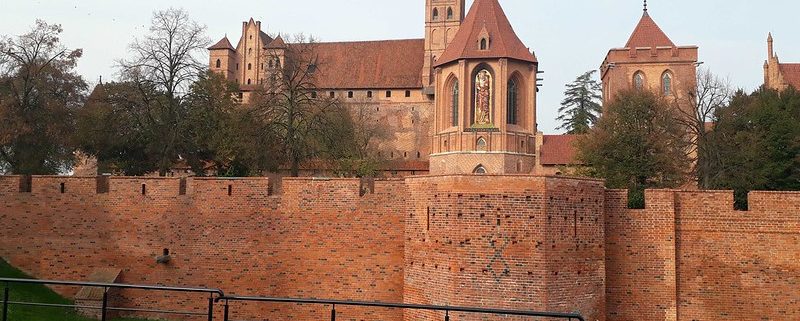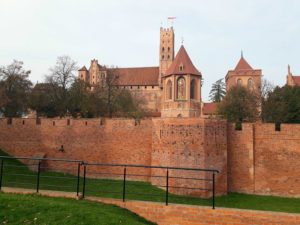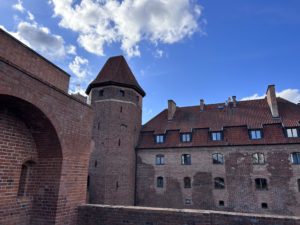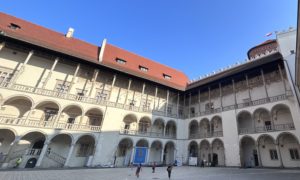Fortifying History: A Look at Castles in Poland
By Suryansh Singh
For me, visiting a castle is a mystical affair. Almost like a teleportation device, these architectural marvels hold the power to transcend one into a world very different from their daily existence, seamlessly coalescing the domains of fantasy and reality. While they are built to withstand arrows and cannonballs, more importantly, they also withstand time. The whispers of vast histories ring in grand towers and courtyards to be heard by the people of the present. Like a notebook with endless pages to be filled in, the often fairytale-like histories of castles evolve, taking a new shape with time. While there may not always be dragons and fairies, there is always a sense of curiosity for me at castles. I had the opportunity to visit Malbork Castle, and Wawel Castle in Poland, where I felt this same curiosity for how the worlds of fantasy and reality collide to tell a historic tale. Encapsulated not only by the sheer size, but also the age of these castles, I could not help but imagine them as sentient creatures in their own right, as observers and tellers of history. Being prompted into my state of wonder, I questioned, “What if time were to stop today, what could these castles tell me about these lands?”. I wondered what would happen if visitors did not have text and guides to give them details. I wondered what the castles would say about who built them, who lived in them, and who fought for them.
At Malbork Castle, in Malbork, the castle presents its visitors with a history laden with faith, destruction, and rebirth. Its many towers and tall brick walls are a testament to its military might, however, a statue of the Virgin Mary, the patron saint of Malbork, informs one of the greater purposes behind the castle. With construction starting in the late 13th century, the main reason behind the castle being built was to house and provide a stronghold for the the Teutonic Order, a knightly brotherhood meant to aid the power and presence of the Catholic Church. The military significance of the castle naturally invited conflict for its control over past centuries. Like healed scars on a warrior, the castle’s defensive walls bear similar scars from the battles it has seen time and time again. While some bricks appear old, discolored, and worn out, others seem fresh as ever. Sustaining destruction over time, the damaged bricks have been replaced on several occasions in order to rebuild the castle. The ones that saw the least damage, towards the base of its defensive walls, date back to the 15th century, when the castle was built. The newest are still being installed in the 21st century, attesting to just how many times the castle has withstood and come back from destruction.
During the Siege of Marienburg in 1410, recently victorious Polish-Lithuanian troops from the Battle of Grunwald began a two-month long siege on the castle, though ultimately defeated, this marked the first major siege on the castle. Even after experiencing several sieges, the changes of guard and regime over the next five centuries, the castle sustained its greatest losses in the 1940s at the hands of the Nazis and the Soviets. While in the late 1930s, the castle would tell tales of being well kept as a fashionable party location for Nazi officials, up to 80% of the castle was estimated to be destroyed in 1945 in the Soviets army’s attempts to expel Nazi troops out of Poland. Renovations and tidying up to slowly bring the castle back to its glory began in the 1950s to encourage tourism, demonstrating the intent of the Polish government to revitalize it again, not as a military stronghold, but as an opportunity for touring public to reflect on, and learn about the history within it. Due to since extended efforts, the UNESCO World Heritage Site still stands tall, stronger than ever as a bard singing the song of its extensive history, testifying about its past through its statues, walls, and bricks.
My infatuation with the otherworldly was catered to a lot more candidly at Wawel Castle, in Krakow. Even before entering, overhearing tour guides and souvenir stores had me confront what was once said to have been a great beast, the Dragon of Wawel Hill. While today, this great beast is commodified as children’s plush toys, a fire-breathing statue, and a fun tale to invite tourists, according to folklore, the establishment of the castle is linked to the defeat of this fearsome dragon by the fabled Price Krakus. Aside from folklore, the grounds of Wawel Castle today also tell the tale of a history identified by political influence, power, and cultural prosperity of the Polish people. To me, if Malbork Castle was an experienced, scarred warrior, Wawel Castle is more of a worldly-wise statesman, an ambassador donning their finest attire, on a mission to spread the word about Poland’s vibrant culture and prosperous past. Built in 1595, by Italian architects invited and contracted by King Sigismund III Vasa, the castle courtyard in its baroque style is a testament to widespread cultural integration within the Polish kingdom, and the far-reaching extent of Polish political and diplomacy.
Today, the castle also boasts a collection of artifacts from many parts of the world, including Turkey under the Ottoman Empire, and China. Aside from being a preserver of culture and the arts, the castle also serves as the symbolic center of Polish politics. From the 11th century up until the 17th century, Krakow was the capital of Poland, and the castle was the primary residence for Polish monarchs. While the majority of the Polish monarchy has lived in the castle, they are also buried in it. Key figures in the nation’s history, such as national poet Adam Mickiewicz, and liberator against the Russian Empire, Józef Piłsudski are buried among them, indicating their importance to the Polish people to visitors.
Along with his wife Maria, Lech Kaczyński, co-founder of the right-wing Law and Justice party (PiS) is also controversially buried in the castle, with critics claiming that his burial in the castle cathedrals tombs was a symbolic move to assert Lech Kaczyński and the party’s importance in Polish history. If time did truly stop, and one did not have ample context on modern Polish politics, no doubt, it would appear as though Lech Kaczyński was a national hero of the same caliber as those buried in his vicinity. While walking through the castle grounds, one can notice placards informing them of the Nazi use of the castle in the late 1930s, and how it was the official base of Hans Frank, the Governor-General of occupied Poland. Symbolically, as occupiers of the land, the Nazis choosing to use this castle as their official place to exact governance reasserts the political relevance of Wawel Castle centuries after the eras of monarchy. Fulfilling its role as a statesman, telling stories of cultural integration, the politics within Poland, and the history related to it, Wawel Castle overlooks Krakow today as a personified representative to a Poland that has lived a life marked by prosperity, widespread influence, and civic impact.

“Tomb of President Lech Kaczyński and his wife Maria in the crypts of Wawel Cathedral” by Jennifer Boyer is licensed under CC BY-SA 2.0.
My fascination with castles, their ability to transcend time, and tell the tale of a history I did not live, but can be transported to by merely visiting them is encapsulated by both Malbork Castle and Wawel Castle. While one stands out as a wise, scarred warrior telling a tale of conflict, rebirth, and valiance, the other is a statesman that notifies me of the far-reaching cultural integration in Poland, and the political intricacies associated with its grounds. Through symbols within them, as long as the castles stand, tales of two different pasts will be told by them for those visiting them and keen to listen.
References
- Britannica, The Editors of Encyclopaedia. “Teutonic Order”. Encyclopedia Britannica, 27 Jul. 2023, https://www.britannica.com/topic/Teutonic-Order. Accessed 31 October 2023.
- Horne, Elizabeth. “Malbork Castle”. Encyclopedia Britannica, 29 Jun. 2023, https://www.britannica.com/place/Malbork-castle. Accessed 31 October 2023.
- Malbork, Castle Museum. “Years 1457 – 1772.” Malbork Castle Museum, 11 Dec. 2022, zamek.malbork.pl/en/home/visit/history-of-the-castle/years-1457-1772/. Accessed 31 October 2023.
- Malbork Castle Museum. “Years 1772 – 1945.” Malbork Castle Museum, 11 Dec. 2022, zamek.malbork.pl/en/home/visit/history-of-the-castle/years-1772-1945/. Accessed 31 October 2023.
- Malbork, Castle Museum. “Years 1945 – Now.” Malbork Castle Museum, 11 Dec. 2022, zamek.malbork.pl/en/home/visit/history-of-the-castle/years-1945-now/. Accessed 31 October 2023.
- Watkin, David John, Coffin, David R. “Western architecture”. Encyclopedia Britannica, 3 Nov. 2023, www.britannica.com/art/Western-architecture/Eastern-Europe#ref489053. Accessed 1 November 2023.
- Johnson, Lily. “Wawel Castle.” History Hit, 5 May 2021, https://www.historyhit.com/locations/wawel-castle/. Accessed 2 November 2023.
- Wawelska, Katedra. The Cathedral of National Poets and Heroes – the Wawel Royal Cathedral of St Stanislaus B. M. and St Wenceslaus M., 2015, www.katedra-wawelska.pl/en/historia-katedry/katedra-wieszczow-i-bohaterow-narodowych/. Accessed 2 November. 2023.
Image Sources
- Lodo. “Wawel Castle, Poland.” Flickr, 29 May 2019, https://flic.kr/p/2j6R7Q4
- Boyer, Jennifer. “tomb of President Lech Kaczyński and his wife Maria in the crypts of Wawel Cathedral.” Flickr, 29 Dec. 2011, https://flic.kr/p/b3VjXt








